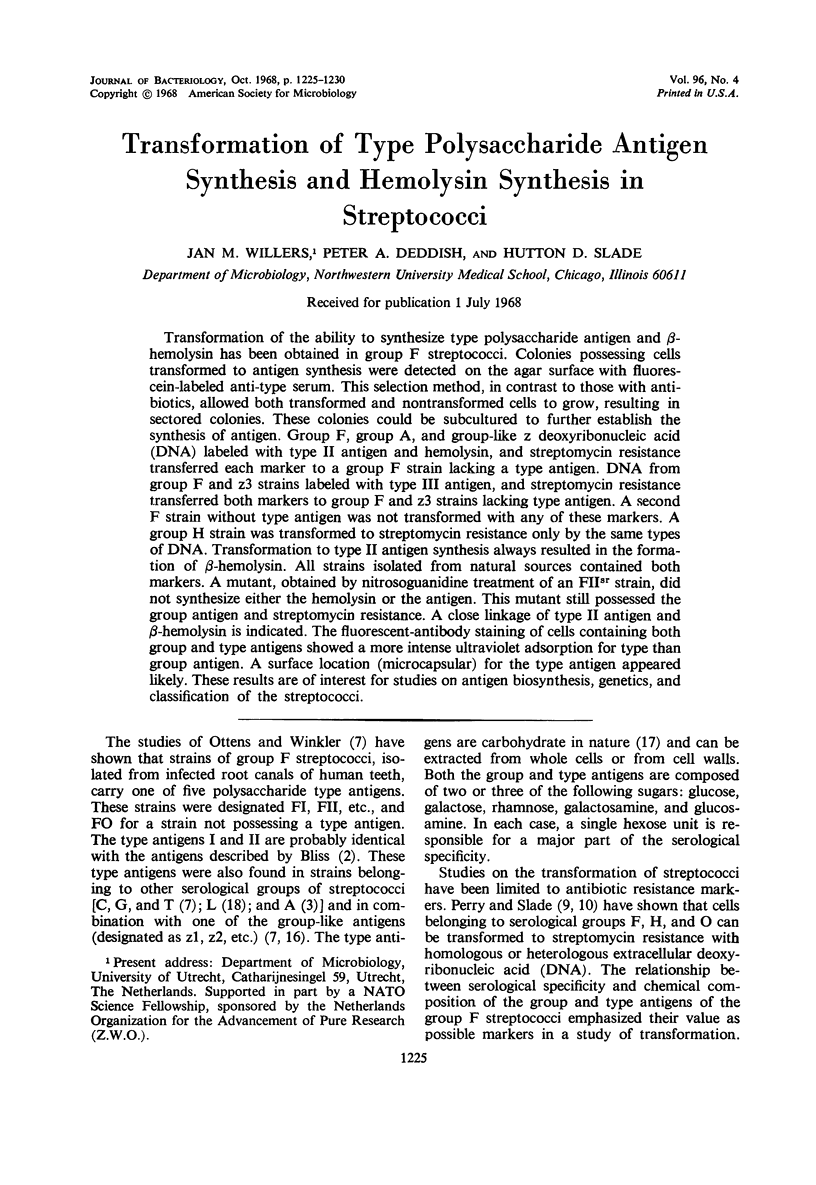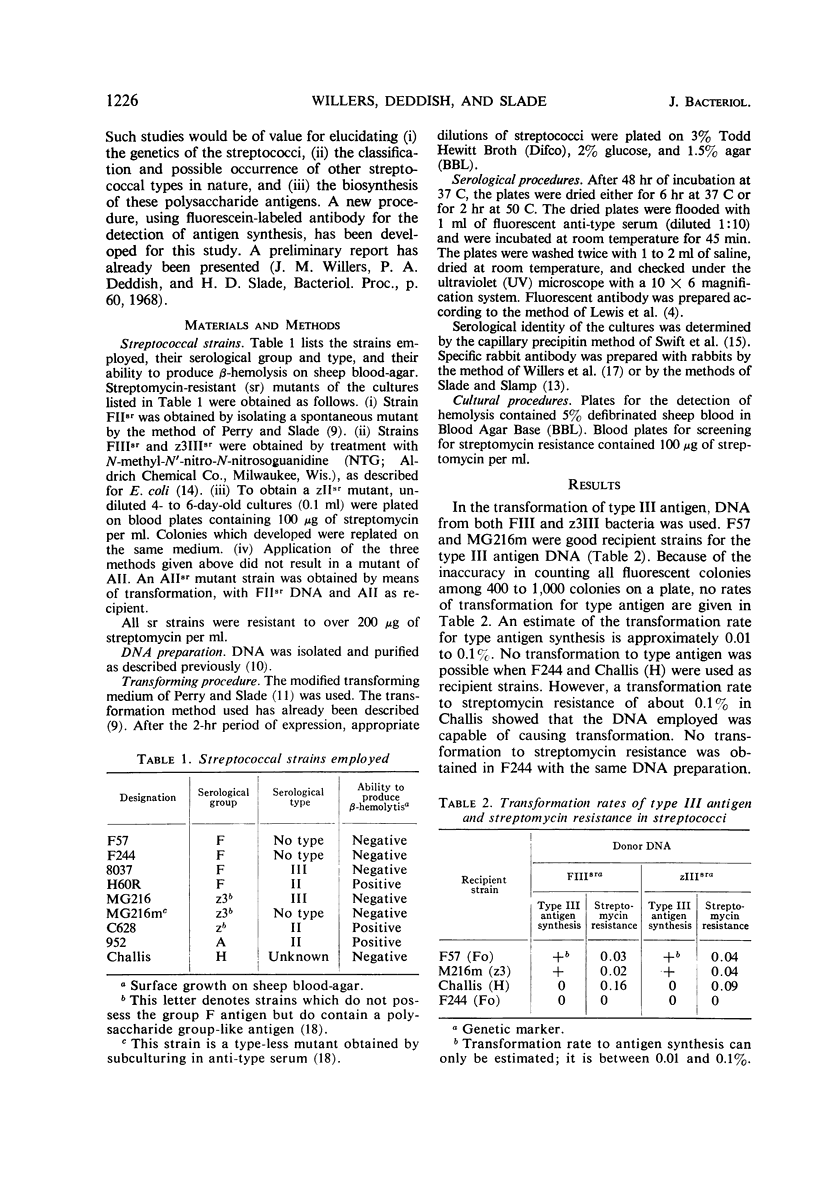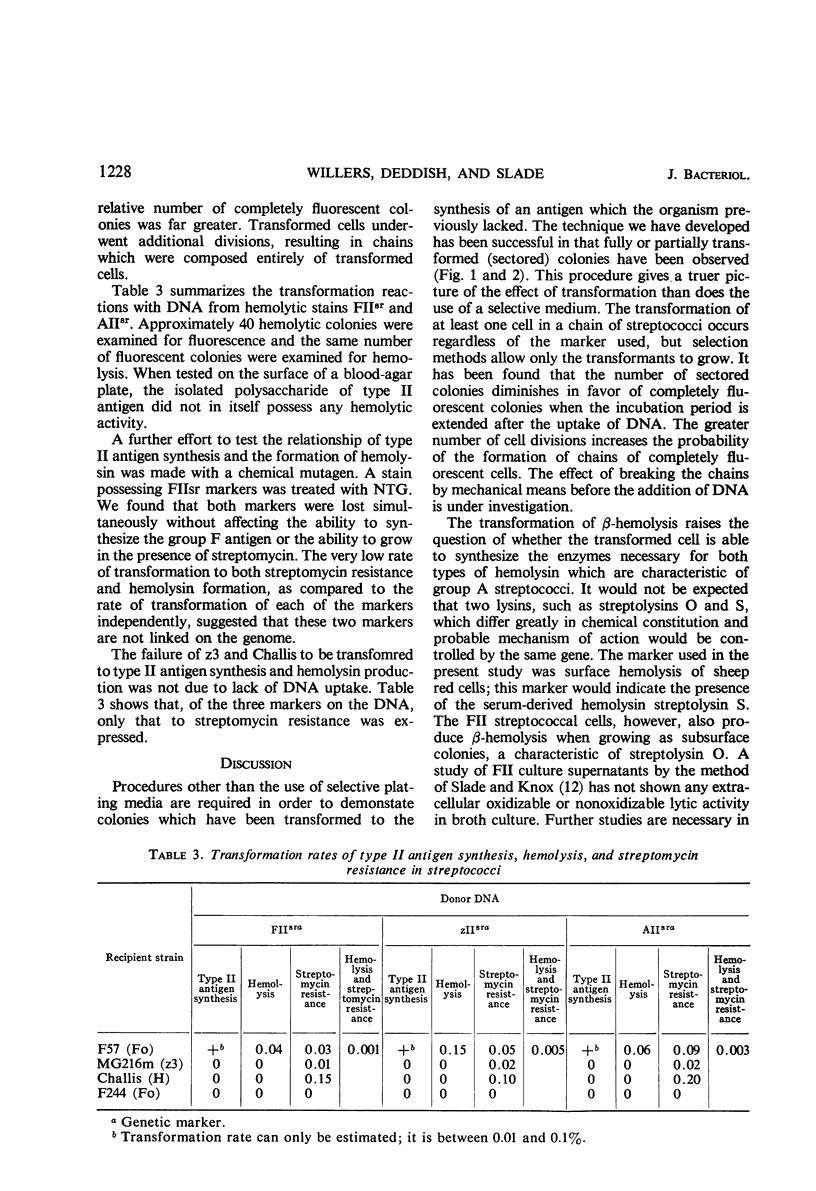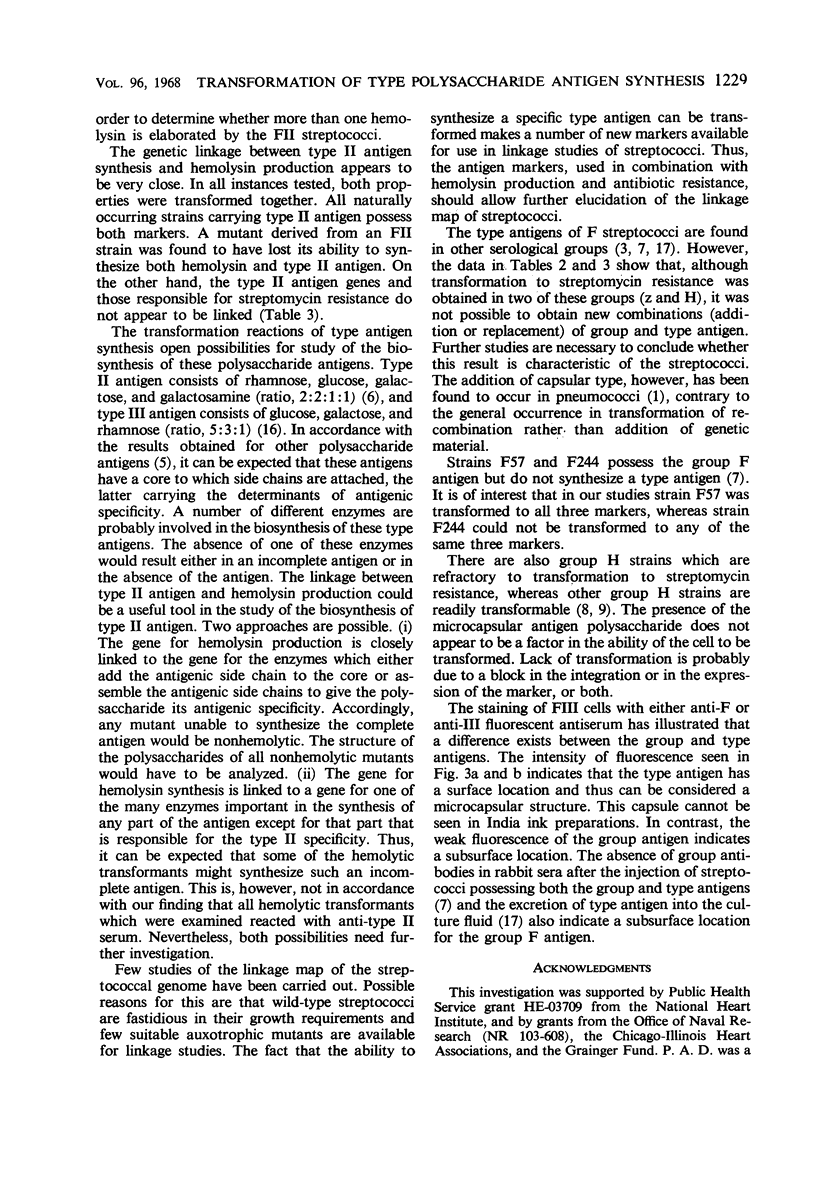Abstract
Transformation of the ability to synthesize type polysaccharide antigen and β-hemolysin has been obtained in group F streptococci. Colonies possessing cells transformed to antigen synthesis were detected on the agar surface with fluorescein-labeled anti-type serum. This selection method, in contrast to those with antibiotics, allowed both transformed and nontransformed cells to grow, resulting in sectored colonies. These colonies could be subcultured to further establish the synthesis of antigen. Group F, group A, and group-like z deoxyribonucleic acid (DNA) labeled with type II antigen and hemolysin, and streptomycin resistance transferred each marker to a group F strain lacking a type antigen. DNA from group F and z3 strains labeled with type III antigen, and streptomycin resistance transferred both markers to group F and z3 strains lacking type antigen. A second F strain without type antigen was not transformed with any of these markers. A group H strain was transformed to streptomycin resistance only by the same types of DNA. Transformation to type II antigen synthesis always resulted in the formation of β-hemolysin. All strains isolated from natural sources contained both markers. A mutant, obtained by nitrosoguanidine treatment of an FIIsr strain, did not synthesize either the hemolysin or the antigen. This mutant still possessed the group antigen and streptomycin resistance. A close linkage of type II antigen and β-hemolysin is indicated. The fluorescent-antibody staining of cells containing both group and type antigens showed a more intense ultraviolet adsorption for type than group antigen. A surface location (microcapsular) for the type antigen appeared likely. These results are of interest for studies on antigen biosynthesis, genetics, and classification of the streptococci.
Full text
PDF





Images in this article
Selected References
These references are in PubMed. This may not be the complete list of references from this article.
- AUSTRIAN R., BERNHEIMER H. P. Simultaneous production of two capsular polysaccharides by pneumococcus. I. Properties of a pneumococcus manifesting binary capsulation. J Exp Med. 1959 Oct 1;110:571–584. doi: 10.1084/jem.110.4.571. [DOI] [PMC free article] [PubMed] [Google Scholar]
- Bliss E. A. Studies upon Minute Hemolytic Streptococci: III. Serological Differentiation. J Bacteriol. 1937 Jun;33(6):625–642. doi: 10.1128/jb.33.6.625-642.1937. [DOI] [PMC free article] [PubMed] [Google Scholar]
- JABLON J. M., BRUST B., SASLAW M. S. BETA-HEMOLYTIC STREPTOCOCCI WITH GROUP A AND TYPE II CARBOHYDRATE ANTIGENS. J Bacteriol. 1965 Feb;89:529–534. doi: 10.1128/jb.89.2.529-534.1965. [DOI] [PMC free article] [PubMed] [Google Scholar]
- LEWIS V. J., JONES W. L., BROOKS J. B., CHERRY W. B. TECHNICAL CONSIDERATIONS IN THE PREPARATION OF FLUORESCENT-ANTIBODY CONJUGATES. Appl Microbiol. 1964 Jul;12:343–348. doi: 10.1128/am.12.4.343-348.1964. [DOI] [PMC free article] [PubMed] [Google Scholar]
- Lüderitz O., Staub A. M., Westphal O. Immunochemistry of O and R antigens of Salmonella and related Enterobacteriaceae. Bacteriol Rev. 1966 Mar;30(1):192–255. doi: 10.1128/br.30.1.192-255.1966. [DOI] [PMC free article] [PubMed] [Google Scholar]
- Michel M. F., Krause R. M. Immunochemical studies on the group and type antigens of group F streptococci and the identification of a grouplike carbohydrate in a type II strain with an undesignated group antigen. J Exp Med. 1967 Jun 1;125(6):1075–1089. doi: 10.1084/jem.125.6.1075. [DOI] [PMC free article] [PubMed] [Google Scholar]
- OTTENS H., WINKLER K. C. Indifferent and haemolytic streptococci possessing group-antigen F. J Gen Microbiol. 1962 Apr;28:181–191. doi: 10.1099/00221287-28-1-181. [DOI] [PubMed] [Google Scholar]
- PERRY D., SLADE H. D. INTRASPECIFIC AND INTERSPECIFIC TRANSFORMATION IN STREPTOCOCCI. J Bacteriol. 1964 Sep;88:595–601. doi: 10.1128/jb.88.3.595-601.1964. [DOI] [PMC free article] [PubMed] [Google Scholar]
- PERRY D., SLADE H. D. Transformation of streptococci to streptomycin resistance. J Bacteriol. 1962 Mar;83:443–449. doi: 10.1128/jb.83.3.443-449.1962. [DOI] [PMC free article] [PubMed] [Google Scholar]
- Pakula R. Production of competence-provoking factor and development of competence of a transformable streptococcus in serum-free media. Can J Microbiol. 1965 Oct;11(5):811–822. doi: 10.1139/m65-110. [DOI] [PubMed] [Google Scholar]
- Perry D., Slade H. D. Effect of filtrates from transformable and nontransformable streptococci on the transformation of streptococci. J Bacteriol. 1966 Jun;91(6):2216–2222. doi: 10.1128/jb.91.6.2216-2222.1966. [DOI] [PMC free article] [PubMed] [Google Scholar]
- SLADE H. D., KNOX G. A. Nutrition and the role of reducing agents in the formation of streptolysin O by a group A hemolytic streptococcus. J Bacteriol. 1950 Sep;60(3):301–310. doi: 10.1128/jb.60.3.301-310.1950. [DOI] [PMC free article] [PubMed] [Google Scholar]
- SLADE H. D., SLAMP W. C. Cell-wall composition and the grouping antigens of Streptococci. J Bacteriol. 1962 Aug;84:345–351. doi: 10.1128/jb.84.2.345-351.1962. [DOI] [PMC free article] [PubMed] [Google Scholar]
- Stouthamer A. H., de Haan P. G., Nijkamp H. J. Mapping of purine markers in Escherichia coli K 12. Genet Res. 1965 Nov;6(3):442–453. doi: 10.1017/s0016672300004328. [DOI] [PubMed] [Google Scholar]
- WILLERS J. M., MICHEL M. F., SYSMA M. J., WINKLER K. C. CHEMICAL ANALYSIS AND INHIBITION REACTIONS OF THE GROUP AND TYPE ANTIGENS OF GROUP F STREPTOCOCCI. J Gen Microbiol. 1964 Jul;36:95–105. doi: 10.1099/00221287-36-1-95. [DOI] [PubMed] [Google Scholar]
- WILLERS J. M., OTTENS H., MICHEL M. F. IMMUNOCHEMICAL RELATIONSHIP BETWEEN STREPTOCOCCUS MG, F 3 AND STREPTOCOCCUS SALIVARIUS. J Gen Microbiol. 1964 Dec;37:425–431. doi: 10.1099/00221287-37-3-425. [DOI] [PubMed] [Google Scholar]
- Willers J. M., Alderkamp G. H. Loss of type antigen in a type 3 streptococcus and identification of the determinant disaccharide of the remaining antigen. J Gen Microbiol. 1967 Oct;49(1):41–51. doi: 10.1099/00221287-49-1-41. [DOI] [PubMed] [Google Scholar]





